Introduction
I started using NHibernate at the end of last year and I am having a wonderful experience with it. The simple fact that I don't have to maintain hundreds of procedures and data access abstraction classes to do basic CRUD operations is enough to justify the use of NHibernate (even though I used a custom code generation tool). Besides that, my code is amazingly clearer and simpler. I only need to worry about business and user interface logic now. All that pluming code is gone for good.
I had zero experience with ORM frameworks, so on the first couple of weeks using NHibernate I had a hard time with some issues, like using it with ASP.NET disconnected objects and abstracting NHibernate sessions from the domain layer. After putting in some effort I came out with a nice architecture that abstracts the NHibernate layer and allows me to work with an ASP.NET session.
Background
I am assuming you already have some familiarity with NHibernate.
If you are new to NHibernate I encourage you to go to the website and download the reference documentation. I am using NHibernate 1.2 CR1 in this article.
The Architecture
The idea here is to keep my business objects unaware of an NHibernate session. So I created a different project for NHibernate stuff, called Shared.NHibernateDAL. It includes the session and transaction manager classes. I also created a common business object that serves as a base class for all my business entities. This class (BusinessObject) encapsulates the common methods and properties all entities that need to be persisted have, like Save(), Delete(), ID, etc.
Here's a class diagram just to give an idea:

The Implementation
The main classes on the NHibernateDAL project are the following:
NHibernateSessionManager – This is the class responsible for managing the NHibernate session. I've got this class from another NHibernate article on Code Project.
TransactionBlock – This is a class I created to manage transactions and abstract it from NHibernate. I will show an example of its use further on this article.
BusinessObject<T> - This is the base class for all the business entities I need to persist. It implements the basic CRUD methods.
Here's the code:
namespace Shared.NHibernateDAL
{
public class BusinessObject<T>
{
public virtual void Save()
{
ISession session = NHibernateSessionManager.Instance.GetSession();
if (!this.IsPersisted)
session.Save(this);
else
session.SaveOrUpdateCopy(this);
session.Flush();
}
public virtual void Delete()
{
ISession session = NHibernateSessionManager.Instance.GetSession();
session.Delete(this);
session.Flush();
}
public virtual T Clone()
{
return this.Clone();
}
public static T Get(int id)
{
if (id <= 0)
return default(T);
else
{
ISession session =
NHibernateSessionManager.Instance.GetSession();
return session.Get<T>(id);
}
}
private int _id;
public virtual int ID
{
get { return _id; }
set { _id = value; }
}
public virtual bool IsPersisted
{
get
{
return this.ID > 0;
}
}
}
}
Using the Code
On this sample we are going to use a Product class to show the features.
Here's the Product class code:
namespace Business
{
public class Product : BusinessObject<Product>
{
public Product()
{
this._name = null;
this._weight = 0;
}
private string _name;
private decimal _weight;
public virtual decimal Weight
{
get { return _weight; }
set { _weight = value; }
}
public virtual string Name
{
get { return _name; }
set { _name = value; }
}
public static List<Product> Select()
{
ISession session = NHibernateSessionManager.Instance.GetSession();
IQuery query = session.CreateQuery("from Product");
return (List<Product>)query.List<Product>();
}
}
}
Because all CRUD functionality is encapsulated on the BusinessObject, the domain entities are as simple as that. Now our Product class is ready to be consumed.
Note that I have included a static Select method that returns a list of products. This might be useful for populating user interface controls, but if you want to completely abstract NHibernate from your domain objects you should create another layer of abstraction under the business layer, containing all HQL queries. But, for small projects, I think it is OK to use HQL inside business objects.
The download file contains three projects, corresponding to the three layers I am using: NHibernateDAL, Business and Web. The Web project is a simple web page showing how easy it is to consume CRUD operations from the Product class.
Transactions
It is often necessary to use nested transactions with objects. You might have a method that opens its own transaction and sometimes needs to be called from another transaction.
To solve this problem and also abstract the NHibernate transaction methods I've come out with the TransactionBlock class. This class keeps track of how many transaction blocks were open and ensures that only one transaction is opened on the database. At the end it commits the transaction only if all blocks were declared valid.
Here's an example of its usage:
public void OutterTransaction()
{
using (TransactionBlock tran = new TransactionBlock())
{
Product p1 = new Product();
p1.Name = "Product 1";
p1.Weight = 10;
p1.Save();
InnerTransaction();
tran.IsValid = true;
}
}
private void InnerTransaction()
{
using (TransactionBlock tran = new TransactionBlock())
{
Product p2 = new Product();
p2.Name = "Product 2";
p2.Weight = 10;
p2.Save();
tran.IsValid = true;
}
}
Conclusion
NHibernate has definitely helped me improve the quality and readability of my code. Combined with code generation tools (like MyGeneration), it can really improve productivity. But be aware, NHibernate and the architecture I am using will not fit every project. Working with legacy database can be a pain, although version 1.2 supports communication with stored procedures.
Any feedback will be greatly appreciated.
 General
General  News
News  Suggestion
Suggestion  Question
Question  Bug
Bug  Answer
Answer  Joke
Joke  Praise
Praise  Rant
Rant  Admin
Admin 











